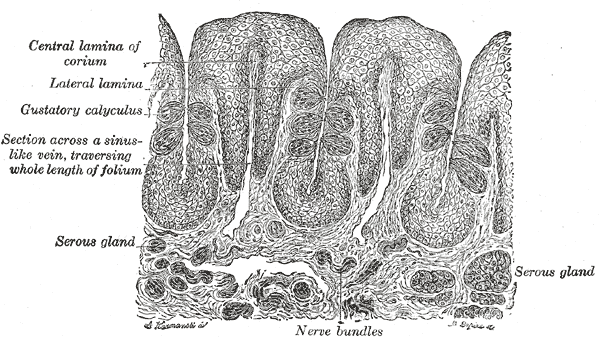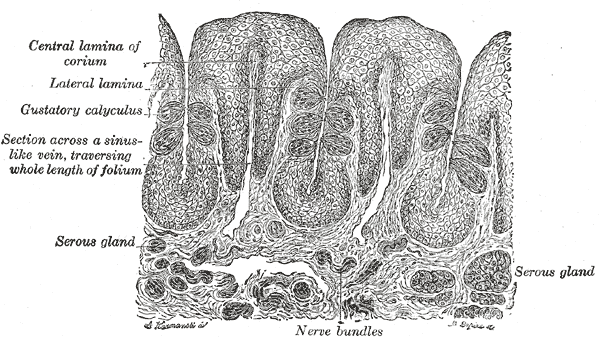Tasty food for anthropological thought

Picture: Taste buds from Gray’s Anatomy
The alleged non-existence of universal colours categories provided a textbook illustration for cultural and linguistic relativism until Berlin and Kay’s published their famous Basic color terms: Their universality and evolution (1969), which has played a major role in the development of cognitive anthropology. On the other hand, the idea of four universal basic tastes, sweet, sour, salty, and bitter, has been generally accepted, even in anthropology. In “A study of the science of taste: On the origins and influence of the core ideas” (Behavioral and Brain Sciences (2008), 31:59-75, freely available online) Robert P. Erickson challenges this idea from a neuropsychological point of view.
Here is the abstract:
Our understanding of the sense of taste is largely based on research designed and interpreted in terms of the traditional four “basic” tastes: sweet, sour, salty, and bitter, and now a few more. This concept of basic tastes has no rational definition to test, and thus it has not been tested. As a demonstration, a preliminary attempt to test one common but arbitrary psychophysical definition of basic tastes is included in this article; that the basic tastes are unique in being able to account for other tastes. This definition was falsified in that other stimuli do about as well as the basic words and stimuli. To the extent that this finding might show analogies with other studies of receptor, neural, and psychophysical phenomena, the validity of the century-long literature of the science of taste based on a few “basics” is called into question. The possible origins, meaning, and influence of this concept are discussed. Tests of the model with control studies are suggested in all areas of taste related to basic tastes. As a stronger alternative to the basic tradition, the advantages of the across-fiber pattern model are discussed; it is based on a rational data-based hypothesis, and has survived attempts at falsification. Such “population coding” has found broad acceptance in many neural systems.
There is a useful outline of the history of the idea of “basic tastes”, and a section on cross-linguistic evidence.
Most of the BBS Open Peer Commentaries of the article are from a neurological point of view, but the parallel with the colour case is drawn by in particular by Tony Belpaeme (his abstract: There are striking parallels between the basic tastes debate and the debate on human colour categorisation. Colour categories show a remarkable cross-cultural similarity, but at the same the time exhibit seemingly inexplicable large interpersonal variations. Recent results suggest that colour categories are the result of cultural learning constrained by the neural substrate of colour perception), and a defense of the idea of basic tastes from a linguistic perspective by Asifa Majid and Stephen Levinson (their abstract: Recurrent lexicalization patterns across widely different cultural contexts can provide a window onto common conceptualizations. The cross-linguistic data support the idea that sweet, salt, sour, and bitter are basic tastes. In addition, umami and fatty are likely basic tastes, as well.)
Tasty food for thought for students of cognition and culture!
4 Comments
You must be logged in to post a comment.



guest guest 28 October 2008 (23:45)
The link is broken, so I can’t comment on the article itself although it looks interesting – Does anyone know of any major cross-cultural differences in which tastes (as opposed to which food items) are considered palatable? Clearly in some cultures certain foods are taboo e.g. we don’t eat insects, but this is not because we don’t like the taste. We never taste them at all. Are there any cultures in which sweetness is not valued, or where bitterness is not disliked? The only foreign food that I’ve ever tried and found disgusting was the durian fruit. But that’s because of the smell, I never even tasted it! — neuroskeptic.blogspot.com
Dan Sperber 29 October 2008 (01:43)
Sorry about the broken link. It is now repaired. As to the more substantial question raised in the previous comment, bitterness is not disliked as such in some culture, it is appreciated for instance in drinks (e.g. Italian ’amari’), chocolates, some vegetables. But a taste for bitter drinks or food is clearly an ’acquired taste’ and an interesting question (from a cultural epidemiology point of view) about cultural differences in taste, is indeed under what conditions and to what extent such tastes can be acquired.
guest guest 29 October 2008 (15:00)
That’s indeed an interesting question. I think that there must certainly be innate preferences for certain tastes, though. Babies like sweet food and reject bitter foods. The same goes for rodents too… — neuroskeptic.blogspot.com
José-Luis Guijarro 3 November 2008 (19:52)
I find Erickson’s paper very interesting but, for the moment, I don’t really see the relevance it may have for cognitive approaches to tastes. Well, yes, it does have some: his passing mention of the human tendency to classify objects/events of the world in five or seven basic kinds is indeed a relevant point. If I understand cognitive approaches rightly, the relationship of concepts to reality does not necessarily rest on a one-to-one mapping accuracy. We have all sorts of cogntive mechanisms that somehow condition our concept formation. And this tendency might be one of them. It would be interesting to research what other innate or acquiered tendencies make us form concepts and set of concepts as it seems we do with tastes. But the issue is as difficult as finding out how we create abstract concepts like, say, [PATRIOTISM] or [LAICISM] or whatever.